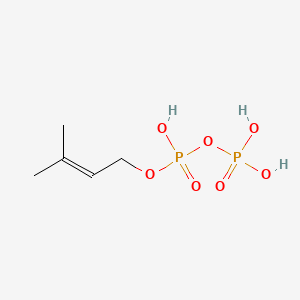| Mann FM et al. |
Rv0989c encodes a novel (E)-geranyl diphosphate synthase facilitating decaprenyl diphosphate biosynthesis in Mycobacterium tuberculosis. |
2011 |
FEBS Lett. |
pmid:21237161
|
| Li Z et al. |
Effect of temperature on postillumination isoprene emission in oak and poplar. |
2011 |
Plant Physiol. |
pmid:21177471
|
| Barrero RA et al. |
De novo assembly of Euphorbia fischeriana root transcriptome identifies prostratin pathway related genes. |
2011 |
BMC Genomics |
pmid:22151917
|
| Tijerino A et al. |
Overexpression of the Trichoderma brevicompactum tri5 gene: effect on the expression of the trichodermin biosynthetic genes and on tomato seedlings. |
2011 |
Toxins (Basel) |
pmid:22069764
|
| Ignea C et al. |
Improving yeast strains using recyclable integration cassettes, for the production of plant terpenoids. |
2011 |
Microb. Cell Fact. |
pmid:21276210
|
| Artz JD et al. |
Molecular characterization of a novel geranylgeranyl pyrophosphate synthase from Plasmodium parasites. |
2011 |
J. Biol. Chem. |
pmid:21084289
|
| Peralta-Yahya PP et al. |
Identification and microbial production of a terpene-based advanced biofuel. |
2011 |
Nat Commun |
pmid:21952217
|
| Bonitz T et al. |
Evolutionary relationships of microbial aromatic prenyltransferases. |
2011 |
PLoS ONE |
pmid:22140437
|
| Du C et al. |
A mutation in the UBIAD1 gene in a Han Chinese family with Schnyder corneal dystrophy. |
2011 |
Mol. Vis. |
pmid:22065921
|
| Xiao Y et al. |
Study of IspH, a key enzyme in the methylerythritol phosphate pathway using fluoro-substituted substrate analogues. |
2011 |
Org. Lett. |
pmid:21981393
|
| Lu J et al. |
Human ovarian tumor cells escape γδ T cell recognition partly by down regulating surface expression of MICA and limiting cell cycle related molecules. |
2011 |
PLoS ONE |
pmid:21935360
|
| Clastre M et al. |
Subcellular evidence for the involvement of peroxisomes in plant isoprenoid biosynthesis. |
2011 |
Plant Signal Behav |
pmid:22080790
|
| Cantagrel V and Lefeber DJ |
From glycosylation disorders to dolichol biosynthesis defects: a new class of metabolic diseases. |
2011 |
J. Inherit. Metab. Dis. |
pmid:21384228
|
| Yeh E and DeRisi JL |
Chemical rescue of malaria parasites lacking an apicoplast defines organelle function in blood-stage Plasmodium falciparum. |
2011 |
PLoS Biol. |
pmid:21912516
|
| Su YH et al. |
Auxin-cytokinin interaction regulates meristem development. |
2011 |
Mol Plant |
pmid:21357646
|
| Nordqvist A et al. |
Synthesis of functionalized cinnamaldehyde derivatives by an oxidative Heck reaction and their use as starting materials for preparation of Mycobacterium tuberculosis 1-deoxy-D-xylulose-5-phosphate reductoisomerase inhibitors. |
2011 |
J. Org. Chem. |
pmid:21936546
|
| Seeger K et al. |
The biosynthetic genes for prenylated phenazines are located at two different chromosomal loci of Streptomyces cinnamonensis DSM 1042. |
2011 |
Microb Biotechnol |
pmid:21342470
|
| Meraviglia S et al. |
γδ T cells cross-link innate and adaptive immunity in Mycobacterium tuberculosis infection. |
2011 |
Clin. Dev. Immunol. |
pmid:21253470
|
| Yu Q et al. |
Plant carotene cis-trans isomerase CRTISO: a new member of the FAD(RED)-dependent flavoproteins catalyzing non-redox reactions. |
2011 |
J. Biol. Chem. |
pmid:21209101
|
| Sui C et al. |
Transcriptome analysis of Bupleurum chinense focusing on genes involved in the biosynthesis of saikosaponins. |
2011 |
BMC Genomics |
pmid:22047182
|
